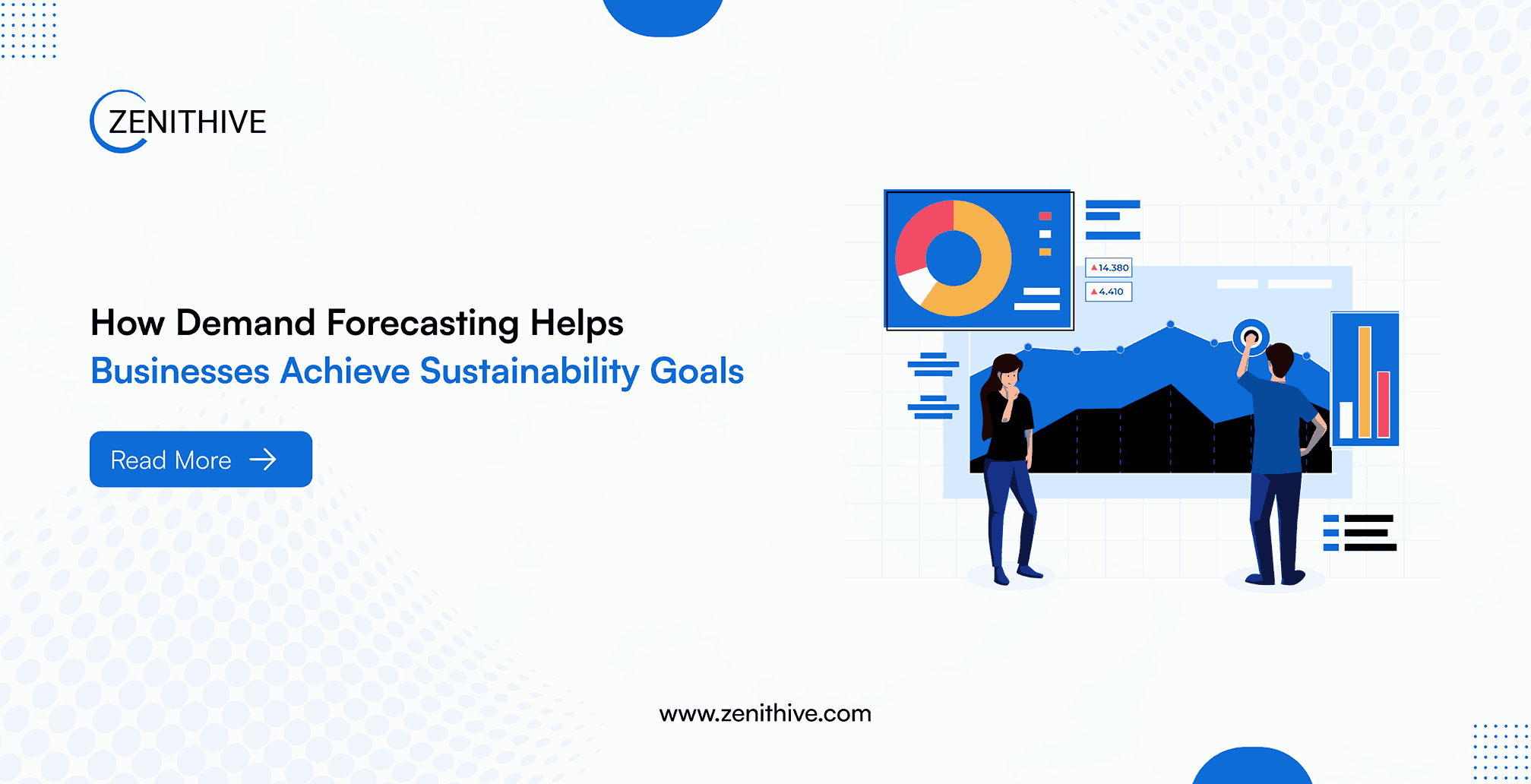Sustainability is no longer a buzzword in today’s business environment, it’s a fundamental strategic imperative. With more and more organizations under pressure from customers, shareholders, and regulatory agencies to minimize their environmental impact, operational efficiency and sustainability objectives are harmoniously converging for many companies. At the forefront of this convergence is demand forecasting, something that Zenithive’s innovative solutions have been powering radically impactful outcomes for visionary companies.
The Sustainability Imperative in Modern Business
Five of the world’s top ten risks in the next decade are environmental, as the World Economic Forum’s 2024 Global Risks Report indicates. In addition, a recent McKinsey survey has discovered that 83% of C-suite leaders and investment experts agree that ESG programs will add more shareholder value in five years than now.
The message is simple: sustainability is not merely about doing good, it’s about making business last in a shifting world.
What Is Demand Forecasting?
At its core, demand forecasting is the analytical process of predicting future customer demand for products or services. It combines historical data, market intelligence, and predictive analytics to create a reasonably accurate picture of future sales trends.
Traditionally, demand forecasting has been viewed primarily through a profitability lens, helping businesses optimize inventory, reduce stockouts, and improve cash flow. However, its sustainability implications are equally profound. At Zenithive, we’ve pioneered the integration of advanced forecasting algorithms with sustainability metrics, helping our clients achieve both financial and environmental objectives simultaneously.
The Hidden Environmental Costs of Poor Forecasting
When we visited a major electronics manufacturer last year, We were struck by a startling scene: a warehouse filled with obsolete components destined for disposal. The procurement manager explained they had overestimated demand for a product line by nearly 40%,a forecasting error that would result in tons of electronic waste.
This scenario plays out across industries every day:
- Food waste: The UN Food and Agriculture Organization estimates that about one-third of all food produced globally is wasted, with poor demand planning being a significant contributor in retail and food service.
- Manufacturing waste: Overproduction is responsible for approximately 20% of manufacturing waste in consumer goods industries.
- Excessive transportation: Expedited shipping due to poor planning increases carbon emissions by up to 30% compared to optimized logistics networks.
The Sustainability-Forecasting Connection
1. Reducing Overproduction and Waste
Accurate demand forecasting allows companies to produce closer to actual market needs, significantly reducing waste across the value chain.
Real-world example: Unilever implemented advanced demand forecasting algorithms in 2022, reducing product waste by 18% while simultaneously improving product availability by 3%. The company estimates this prevented approximately 50,000 tons of food waste annually across their global operations.
Zenithive solution:We helped a mid-sized food manufacturer reduce overproduction by 22% in just six months. By implementing our proprietary dynamic demand sensing algorithms, they prevented more than 1,500 tons of food waste annually, equivalent to feeding approximately 2,500 people for a year.
2. Optimizing Resource Utilization
When businesses have clearer visibility into future demand patterns, they can optimize resource allocation, from raw materials to energy consumption.
Case study: A leading Swedish furniture retailer implemented machine learning-based demand forecasting that reduced raw material purchases by 11% while maintaining the same production output. This translated to 13,000 fewer trees harvested annually for their wood-based products.
3. Streamlining Supply Chain and Transportation
Better forecasting means more efficient logistics planning, reducing unnecessary transportation and the associated carbon emissions.
Industry impact: According to a 2023 study by MIT’s Center for Transportation and Logistics, implementing advanced demand forecasting can reduce transportation-related carbon emissions by 15-22% in retail supply chains.
4. Reducing Energy Consumption
With more accurate production planning, manufacturers can optimize production schedules to reduce energy use during peak periods and minimize idle equipment time.
Real-world application: A pharmaceutical manufacturer in Ireland implemented AI-driven demand forecasting in 2023, achieving a 14% reduction in energy consumption by optimizing production schedules while still meeting all customer delivery deadlines.
5. Extending Product Lifecycles
Better understanding of long-term demand trends enables companies to design products with appropriate lifecycle expectations, reducing the frequency of model changes and associated waste.
Example: Tesla’s demand forecasting for battery components has allowed them to design battery systems with replaceable modules rather than requiring full battery replacement, extending vehicle lifespans by an estimated 40%.
Modern Forecasting Technologies Driving Sustainability
The rapid evolution of forecasting technologies is making these sustainability benefits more accessible:
- Machine learning and AI: Today’s algorithms can process vastly more variables than traditional statistical models, increasing forecast accuracy by 30-50% in complex product categories. Zenithive’s neural network forecasting models consistently outperform conventional systems by an average of 37% in complex, multi-variable environments.
- Real-time data integration: Modern systems can incorporate point-of-sale data, social media trends, and even weather patterns to create dynamic forecasts. Our ZenConnect platform integrates over 30 different data sources in real-time, providing unprecedented forecast accuracy.
- Collaborative platforms: Allowing suppliers and retailers to share forecasts reduces the “bullwhip effect” that historically led to overproduction. Zenithive’s Supply Chain Collaboration Suite enables secure, transparent forecast sharing across complex value chains.
Challenges and Limitations
Despite its potential, integrating demand forecasting into sustainability initiatives faces challenges:
- Data quality issues: Many organizations still struggle with siloed, incomplete, or inconsistent data.
- Organizational resistance: Forecasting often crosses departmental boundaries, requiring collaborative approaches that can meet resistance.
- Balancing objectives: Sometimes the most cost-effective forecast isn’t the most sustainable, creating decision tensions.
Implementation Strategies: Making Forecasting Work for Sustainability
For organizations looking to leverage demand forecasting for sustainability goals, consider these approaches:
- Start with baseline metrics: Quantify current waste, overproduction, and resource utilization as a starting point. Zenithive’s Sustainability Assessment Tool can help you establish these baseline metrics with minimal disruption to your operations.
- Integrate sustainability KPIs: Expand forecasting performance metrics beyond accuracy to include sustainability impacts. Our ZenDashboard includes customizable sustainability metrics that integrate seamlessly with financial performance indicators.
- Build cross-functional teams: Bring together sustainability experts and forecasting professionals to identify opportunities. Zenithive’s implementation consultants specialize in facilitating these collaborations.
- Invest in technology: Modern AI-driven forecasting tools offer significant improvements over traditional methods. Zenithive’s scalable solutions can be implemented without disrupting existing systems, with ROI typically achieved within 6-9 months.
- Communicate the dual benefit: Frame improved forecasting as both a cost-saving and sustainability measure to gain broader organizational support. Our client success stories provide compelling evidence for building your business case.
The Future of Sustainable Forecasting
The integration of sustainability and demand forecasting will likely accelerate in coming years. Emerging trends include:
- Carbon-aware algorithms: Forecasting tools that explicitly consider carbon impact in their recommendations.
- Extended forecasting ecosystems: Sharing forecasting data across supply chain partners to optimize system-wide sustainability.
- Regulatory integration: As carbon pricing becomes more common, forecasting systems will adapt to include these factors in optimization.
Conclusion: A Win-Win Proposition
Accurate demand forecasting represents that rare win-win, reducing costs and environmental impact while improving customer satisfaction.
For businesses serious about meeting sustainability goals while maintaining or improving profitability, enhancing demand forecasting capabilities should be at the top of the strategic agenda. The tools exist, the business case is clear, and the environmental imperative is increasingly urgent. The only question remaining is: how quickly can your organization implement these changes?
Ready to explore how Zenithive’s forecasting solutions can drive your sustainability goals? Contact our team of experts today for a personalized demonstration and assessment. Our clients typically see a 15-25% reduction in waste-related costs within the first year of implementation, alongside measurable progress toward sustainability targets.



